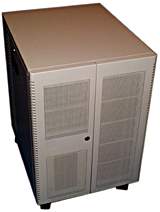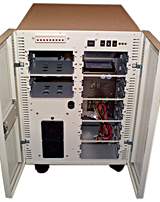
Topower TP-1400 server case
Review date: 12 April 1999. Last modified 03-Dec-2011.
If you're building a serious IBM-compatible server, you need a serious case. You need tons of drive bays, and easy access to the innards, and locks to prevent the wrong people easily accessing the innards. Because cases with tons of drive bays have to be huge, you also need casters on the bottom so you don't rupture yourself trying to move the thing, and because tons of drives make tons of heat you also need lots of fans. Because you don't want a Power Supply Unit (PSU) failure to kill whatever services the server is providing, you need redundant power supplies - if one dies, you can yank it out and leave the other one running the server until you can slap a new PSU unit in.
And you probably don't care enormously about how much this case costs, because it's pretty much certain to be a great deal less than the price of the stuff you're going to put into it.
Topower's TP-1400 "bar fridge" case fits the bill in all of the above departments.
It has 14 5.25" drive bays, all of which have front access and so all of which can, if you wish, be used for removable media. It has lockable front doors and side panels, dual power supplies (each 400 watt, in the model I reviewed), and six 80mm fans, plus the two in the power supplies, mounted as standard. It also passes muster in the tightly contested "it costs how much?!" category. If you're used to a $200 (Australian dollars) case being classed as remarkably expensive, you'd better sit down before you start pricing server cases. The Topower retails for well over $2000, including the dual redundant 400 watt PSUs. Ex tax dealer pricing is in excess of $1500.
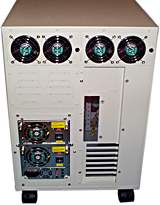
The back of the case. Below the twin fans at the
left are the punch-outs for various connectors not associated with the motherboard
(for external SCSI devices, for instance). Below the twin fans at the right
is a punch-out for yet another 80mm fan.
A significant chunk of this expense goes into the power supplies. The going rate for twin hot-swappable redundant 400 watt power supplies and the cradle they plug into is currently around $US500 retail, or about twice that number for Australian dollars. All current computer power supplies can operate on 110-120 or 220-240 volt mains at the flick of a switch, so the supply you buy in the States is probably the same as the supply you buy in Europe or in Asia or here in Australia.
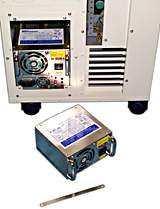
The hot-swap redundant power supplies are retained
with a metal strip held on by two screws. With the strip out, yank out the
PSU you want to remove and you can immediately replace it with another.
The power supply makes up a large slice of the price of ordinary PC cases, too, but there's a big premium for dual supplies. A single, plain 300 watt ATX PSU, as found in most larger PC cases, costs about $70 (Australian dollars) retail. A pair of redundant 300 watt supplies are at least 10 times as expensive.
So when you subtract the price of the PSUs, and consider that this is a low volume, specially imported item (most computer stores sell literally hundreds of plain mini-tower cases for every server case), the price starts to look less outrageous.
I harp on about this because the high purchase price - ten or twenty times what you pay for a plain PC case - might lead you to think that this server case should offer hand crafted, gold standard build quality and features. And it doesn't. It's not a bad case, but it's far from perfect. For the money, it's actually still not poor value.
What you get
So, after all that, what's in the box?
Well, most of it's filled by the 615mm by 410mm by 505mm (height, including casters, by width by depth) bulk of the TP-1400 itself. This is roughly the size of two standard full tower cases side by side. With power supplies, the TP-1400 weighs something like 29.5 kilograms (65 pounds), again roughly the same as two tower cases.
Mind you, I had to tilt it onto the bathroom scales to find out what it weighed. Why? Because for some bizarre reason, Topower's cases come with no documentation. Nothing. Not so much as an exploded diagram with amusingly fractured English annotations. Fortunately, there's not much that's special about a server case, even one with dual PSUs, and the kind of person that buys one is likely to know what they're doing and not need much documentation, but nothing?
Along with the case you do at least get the usual little box of bits. A plethora of screws, cable anchors, nylon cable ties, motherboard mounts and so on are in one bag, which includes various obscure bits of plastic for mounting ATX, AT and IPC motherboards, all of which fit in the TP-1400. There's a little bundle of plastic end-guides for full-length expansion cards, if you install any. And there's various metalwork as well.
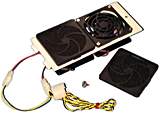
The front fan assembly, with one of the washable
dust filters unclipped. The rear fans are similarly mounted in two-fan modules,
which can each be removed by extracting only one screw.
You get slot covers for any expansion card slots you don't use, but most of the bits box is taken up with the 28 side rails for drive mounting. The rails screw into the standard mounting holes on all 5.25" drives and have a little spring clip thing at the front. Once you've put a pair of rails on a drive, you can slide it into a bay from the front and it'll just click into place, and stay there quite solidly until you choose to remove it.
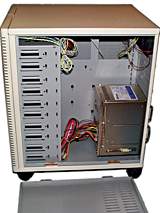
The right side, where most of the drive bays and
the two PSUs live. The side panels are secured with a keylock, which will
keep out the casually curious.
There is, however, no way provided to mount any 3.5" drives in the TP-1400, not even a floppy drive. This is no big deal - 5.25 to 3.5 inch mounting rails and cradles are readily available - but it's something to bear in mind if you need to mount the smaller drives.
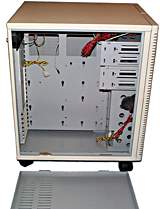
The left side, where the motherboard mounts. If
you look closely you'll see there's only one of the copper contact springs
installed at the bottom, where the side panel's tabs mate with the main
chassis. The contact springs maintain a really solid electrical connection
between the side panel and the rest of the chassis, for RF shielding purposes.
Neither contact was installed on this side, and I only found one of them
rattling around inside the case before taking the picture. The other one
turned up on the other side of the motherboard mount panel. I think it's
quite unlikely that loose hardware bouncing around inside could, for instance,
pop into a PSU cooling slot and cause problems, but it's not impossible.
Any unused bays can be blanked off with the included ventilated front panels. The bits box also includes two keys for the front and side panel locks. The keys are the barrel type, which makes the locks harder to pick, but they still offer no real security; anybody with a flathead screwdriver could wrench the case open easily.\
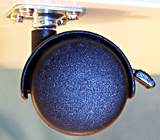
The little levers on the casters lock them, making
your server less likely to wander the halls in search of mini-towers to
eat.
Construction
Like all decent cases, the TP-1400 is made from 1mm mild steel plate, painted the ubiquitous beige. Everything you might want to rapidly remove and replace is built to make it easy - the fans mount on plates retained with one screw and a tab in a slot, for instance, and the dust filters on the sucking fans at the front are easy to unclip for cleaning. Taking off the side panels is trivially simple; unlock them and hinge them down and that's it. Working on the innards of the case is made easy by this and by its sheer size; even the cable jungle that often grows behind a bank of drives should be easy enough to manage when you've got the equivalent of a whole tower case of space to do it in.
One thing about both this case and the rack-mount TP-1945 (reviewed here) which definitely didn't impress me is the sharpness of all of the edges inside. That's right – both of these high-priced cases have the same sharp stamped metal construction that you'll find in a $70 mini-tower, or a car stereo mounting cage, for that matter.
Sharp metal in a dirt cheap case I can accept. Sharp metal in something costing more than a thousand dollars is rubbish. AOpen can roll the edges of the metalwork in a midi-tower case that retails for $145 (I review their HX-45 here), but Topower can't do it in a case that costs well over ten times as much? Bah!
Admittedly, the snap-in mounting system and capacious design of a server case like the TP-1400 means you're less likely to lacerate yourself on sharp edges, but that's no excuse. Fortunately, the sharp metal and the lack of a manual are the only serious flaws I found.
Overall
So, as I said before, overall this case is not too bad for the money. I've no idea why it's got no manual, and the sharp edges are annoying, but apart from that it's got ticks in all of the right boxes and represents acceptable, though not excellent, value for money. If you're an average user who's just looking to impress his buddies with a big mean-looking computer, I recommend you put the money into counselling rather than a bar-fridge case. But if you're building a proper server, the Topower is worthy of consideration.
